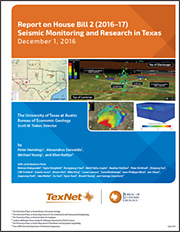Synopsis: Conduct coupled thermo-poroelastic numerical simulations to assess the importance of key parameters in controlling fault reactivation using site-specific controls
Project Status: active
Funding Source: 100% TexNet
Research Leaders: Peter Eichhubl, Zhiqiang Fan
Project Start: 1Q2016
Project Interface: Project interfaces closely with Faults and Geomodels, Pore Pressure Analysis of Ft. Worth Basin, and Multi-Institutional and Industrial Collaboration for Geomechanical and Seismicity Assessment of the Ft. Worth Basin
Expected research outcomes:
- Models relating injection to possible stress changes on nearby faults for recorded earthquake sequences
- Physical models of stress and pore pressure transfer between injection wells and potentially active earthquake faults for a range of fault and reservoir geometries and flow properties.
- Sensitivity analysis of geomechanical models on the quality of input parameters
An important aspect of evaluating seismic risk and devising approaches to minimize seismic risk is an understanding of reservoir fluid flow and its geomechanical implications. Numerical simulations of pore fluid pressure and in-situ stress changes associated with fluid injection and production can be used to derive predictive models that relate natural processes and human activity to past and possible future earthquake activity. Geomechanical simulations can determine the plausibility of shear failure in certain areas depending on initial conditions and provide guidance as to whether modified injection practices (e.g., lower rates or pressure, limits on total volumes) can reduce the potential for seismic events. Simulation will also guide instrument deployment in the field and inform geological and geophysical data collection strategies.
This project will assess the effects of fluid production and injection on the stability of nearby faults using coupled poroelastic and thermo-poroelastic numerical simulations. Using 2D and 3D finite element simulations, we will assess the effect of multiple production and injection wells, heterogeneity in reservoir and fault permeability, and in situ stress state. Simulations will also investigate processes that may allow stress and pore pressure transfer between porous injection horizons and underlying basement to assess mechanics of earthquake nucleation in basement rocks. Simulations will be run with both generic fault and injection geometries as well as geometries informed by available subsurface structure and permeability information for recorded earthquake sequences with known injection and production history of nearby wells.
